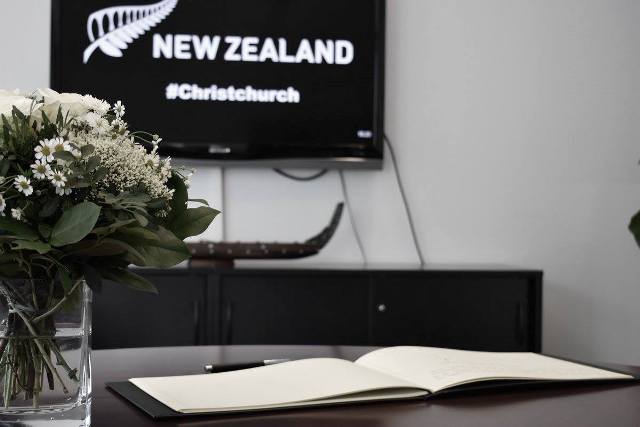 "There was an outpouring of collective grief in Christchurch, a city of 400,000, as New Zealand rallied to support its Muslim community." [photo: NZ Foreign Affairs Ministry]
"There was an outpouring of collective grief in Christchurch, a city of 400,000, as New Zealand rallied to support its Muslim community." [photo: NZ Foreign Affairs Ministry]
The quiet, provincial city of Christchurch became the scene of a massacre of 50 Muslim men, women and children in two mosques by a white supremacist that convulsed a nation unused to racist killings and a world that had viewed New Zealand as a peaceful backwater. Brenton Tarrant, a 28-year-old Australian, has been charged with murder. Police said he intended to continue his attack and had more guns in his car.
There was an outpouring of collective grief in Christchurch, a city of 400,000, as New Zealand rallied to support its Muslim community. Those murdered ranged from toddlers to old men; 34 people were wounded, 12 critically. One man was killed in front of his children. Victims included refugees from Syria and Afghanistan; others were from countries including Bangladesh, India, Jordan, Pakistan and Turkey. New Zealand accepts 1,000 refugees a year plus asylum-seekers (relatively few by population – 47 times fewer than Sweden in 2014).
The gunman planned for the attack to go viral, livestreaming footage of the massacre on Facebook – the Daily Telegraph called it the ‘first social media terror attack’. The 17-minute footage was quickly taken down by the social-media company but not before it had been viewed countless times (one upload was watched 23,000 times in an hour) and shared across YouTube, Twitter and Instagram. The suspect also posted a rambling ‘manifesto’ on the ‘world’s most vile website’, 8chan, proclaiming his motives with white supremacist tropes. Two British newspapers were condemned for putting the footage online, with the Daily Mail even allowing readers to download the shooter’s 74-page post. According to The Atlantic, the document was ‘designed to troll’, cleverly baiting the media and social-media users to gain maximum attention online by citing popular internet memes such as PewDiePie. He also refers to the British fascist leader Oswald Mosley, neo-Nazi conspiracy theories such as ‘The Great Replacement’, Serb nationalist propaganda and Candace Owens, a black American who is a US ‘alt-right’ figurehead. The Bellingcat analyst Robert Evans said: ‘This manifesto is a trap itself, laid for journalists searching for the meaning behind this horrific crime.’
The prime minister, Jacinda Ardern, described it as a terrorist attack and one of New Zealand’s ‘darkest days’, saying of the victims: ‘They are us.’ Within days her cabinet had agreed in principle to ban the semi-automatic guns and larger magazines used in the shootings. Ardern told New Zealand’s parliament that she would not use the suspect’s name, saying: ‘He sought many things from his act of terror, but one was notoriety – that’s why you will never hear me mention his name.’
The gunman also praised Donald Trump in his manifesto, calling the US president ‘a symbol of renewed white identity and common purpose’. Trump dismissed a question about the rising threat of white nationalists – ironically, just after vetoing an attempt to block his mooted wall on the US-Mexican border and warning of an immigrant ‘invasion’, the New Yorker noted. The statistics say otherwise: according to the Soufan Center, 73% of all US killings by extremists have been by the far right. ‘By every metric, right-wing extremism is the most serious terrorist threat,’ it said, ‘though jihadists still garner the lion’s share of media attention.’ In Australia, comments by a far-right senator, Fraser Anning, who blamed Muslim immigration for the massacre, and by Pauline Hanson, whose One Nation party has long stoked anti-Muslim rhetoric, have highlighted the depth of xenophobic feeling in the suspect’s homeland.
Saeb Erekat, the Palestinian peace negotiator, called the attack a ‘consequence of racist ideologies that continue trying to promote religious wars’. He compared it to the slaughter of Jews in a Pittsburgh synagogue in October by an American neo-Nazi and murderous attacks on Coptic churches in Egypt by Islamist militants. Trump, however, fell back again on conservatives’ reassuring dictum that such massacres are down to a few loners with ‘very serious problems’. After an anti-fascist protester was murdered at a white supremacist rally in Charlottesville, Virginia, in 2017, Trump defended the fascists, saying there were ‘very fine people on both sides’. Leaders of the white supremacist movement in the US said they felt ‘energised’ by Trump’s remarks.
Far from being disturbed loners, perpetrators of far-right attacks from the 1995 Oklahoma City bombing to Christchurch are ideologically driven and well-connected individuals who get validation and knowhow (such as bomb-making) online, from tech-savvy global networks, whether they be Islamic State insurgents in the Middle East or white supremacists in the Mid West. Though they appear to be polar opposites, the jihadist fighting for Isis in Syria and the neo-Nazi gunman who attacks Muslims in New Zealand have much in common: sharing the same desperate need for meaning and identity, blind devotion to a violent cause and anger at their perceived victimisation.



